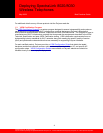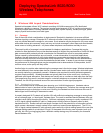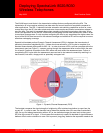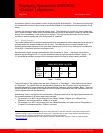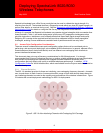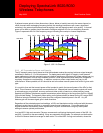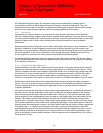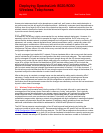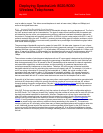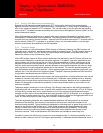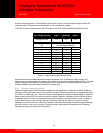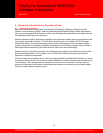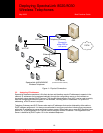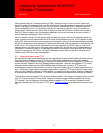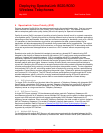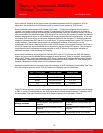
Deploying SpectraLink 8020/8030
Wireless Telephones
May 2009 Best Practices Guide
may be able to support. This allows some telephones to work at lower rates (1Mbps and 2Mbps) and
some at the highest data rates.
2.3.1 Access Point Bandwidth Considerations
There are several factors which determine the AP bandwidth utilization during a telephone call. The first is
the VoIP protocol used and its characteristics. The type of codec utilized combined with the packet rate
will determine the size of the voice packets along with any additional overhead information required for
the protocol. Payload data will generally account for 30-50%of a typical voice packet, with 802.11 and IP
protocol overhead filling the rest. The 802.11 protocols include timing gaps for collision avoidance, which
means bandwidth utilization is more accurately quantified as a percentage of available throughput rather
than actual data throughput.
The percentage of bandwidth required is greater for lower 802.11b data rates; however it is not a linear
function because of the bandwidth consumed by the timing gaps and overhead. For example, a call using
standard 64 Kbps voice encoding (G.711) utilizes about 4.5 percent of the AP bandwidth at 11 Mbps, and
about 12 percent at 2 Mbps. In this example, four simultaneous calls on an AP would consume about 18
percent of the available bandwidth at 11 Mbps or about 48 percent at 2 Mbps or about 90 percent at
1Mbps.
The maximum number of simultaneous telephone calls an AP can support is determined by dividing the
maximum recommended bandwidth usage by the percentage of bandwidth used for each individual call.
Note that approximately 20 to 35 percent of the AP bandwidth must be reserved for channel negotiation
and association algorithms, occasional retries, and the possibility of occasional transmission rate
reductions caused by interference or other factors. Therefore, 65 to 80 percent of the total available
bandwidth should be used for calculating the maximum call capacity per AP. For example, if all calls on
an AP are using a theoretical 5.4 percent of the bandwidth at 11 Mbps, the actual number of calls
expected at that rate would be about 12 (65 percent of bandwidth available / 5.4 percent theoretical
bandwidth utilized per call). Lower overall bandwidth is available when there are a greater number of
devices associated with an AP or when lower data rates are used for the telephone call or calls.
Even with all of the known variables, there are many other vendor-specific characteristics associated with
individual APs that make it difficult to quantify the precise number of concurrent calls per AP, without
thorough testing of specific configurations. Polycom’s VIEW Configuration Guides
identify the maximum
number of calls per AP for specific models that have been tested to be compatible with the SpectraLink
handset.
With SVP, Polycom provides the ability to limit the number of calls per AP with a configurable setting in
the SVP Server. The “Calls per Access Point” setting limits the number of active calls on each AP and can
be used to set aside bandwidth for data traffic. Wireless Telephones in-call are free to associate with
other APs within range that have not reached the set maximum number of calls. Polycom requires this
setting to be equal to or below the maximum number of calls recommended in VIEW Configuration
Guides. It is still possible for the number of phones associated to an AP to exceed the maximum number
of calls as would be the case with any additional clients associating to the same AP. The maximum
number of calls per AP will simply control how many of those associated phones will be able to enter into
a call. Additional phones beyond the maximum number specified will be forced by the SVP Server to
roam to a new AP that has not reached the maximum calls per AP. If no APs are available any phones
beyond the maximum will display an error message indicating there is insufficient bandwidth to complete
the call.
12
©2009 Polycom, Inc. All rights reserved.
Polycom and the Polycom logo are registered trademarks of Polycom, Inc. All other trademarks are the property of Polycom, Inc. or their respective companies.



